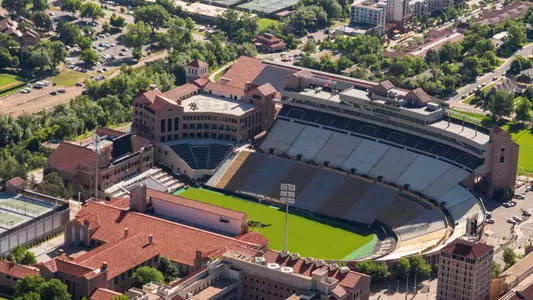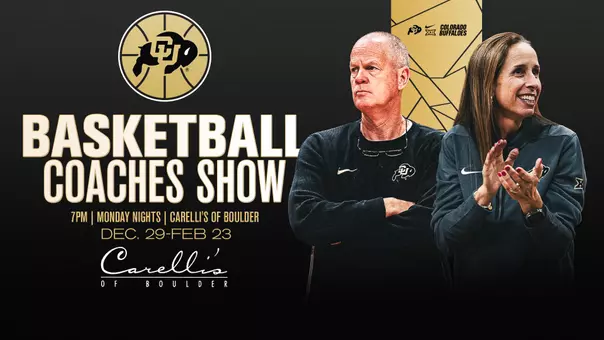Colorado University Athletics

CU Stadium History, Part III: Champions Center Adds World-Class Cornerstone To Folsom
November 25, 2016 | Football, General
This is the third installment of a three-part series, written by CU student David Collins, on the history of football stadiums on the CU campus, from Gamble Field to the current version of Folsom Field. Part I and Part II ran earlier this year.
BOULDER – Folsom Field has been growing since it opened in 1924. Starting with just a humble bowl at the foot of the Rockies, Folsom began expanding in 1956 with the addition of the second deck of seating across the western and southern parts of the bowl.
That tradition of expansion and growth has continued throughout the stadium's history. After the 1991 season and the addition of the Dal Ward Center, Folsom Field was ready to bring its national championship-winning tenants through the 1990s and into the new millennium.
One last major change to Folsom Field before entering the 21st century came in 1999, when CU decided to make the switch back to natural grass after 28 seasons with artificial turf as the playing surface. The process included not only swapping out the Astroturf, but also adding a bio-thermal heating system, a new drainage system and a sub-air system, all costing a total of $1.2 million.
Along with the new playing surface, a new video system, costing $3.6 million, was installed during the summer of 1999. The video boards, known as "BuffVision," still sit at both ends of the stadium.
Those changes to Folsom brought the old stadium into the 21st century, but the old bowl wasn't finished expanding just yet.
Before any physical changes to Folsom occurred in the new millennium, the athletic department began the process of changing the mentality of everything involved with CU's athletic program and its development across the board.
Involving the entire athletic department, "Athletics 2010" was a four-step process that had the goal of growing the athletic department, both on the field and in the classroom. The four-step process started with education and concluded with the goal of expanding the facilities across the entire department.
Folsom Field was a big part of that expansion plan, but the Coors Events Center would also receive an upgrade by the addition of new practice facilities as a part of the growth of CU's athletics.
In 2003, Folsom grew again with the addition of luxury boxes on the eastern side of the stadium.
"There was a 10-year plan we had come up with and the first phase of it was building the boxes and the club seats that are up there, and it was all one project," said John Meadows, an associate athletic director at CU when the expansion was planned and completed. "It was a two-year project to build the boxes. We broke ground right after end of the 2001 season and when the 2003 season started, we opened up the completed luxury boxes and club seats."
When all was said and done, the entire project cost $45.2 million and added 1,903 club seats and 41 suites.
What made the suites unique in comparison to other stadiums was their location and view. Unlike other places across the country, Folsom's configuration allowed the suites to be built relatively close to the field, giving fans a great view of the action below.
But it was the view away from the gridiron that made the expansion a special place for anyone coming to a game at Folsom. Sitting in the club seats or the luxury boxes provides a perfect view of one of Folsom Field's greatest attractions, the Flatirons.
With new suites and box seats looking over the field, Folsom Field was ready to move forward in expansion. It would take a few years before that would happen, but what would eventually end up in the northeastern corner of Folsom Field had its foundation laid during the two years the suites and boxes were being built above Folsom Field.
"When we got ready to start the boxes, we then worked on and did the infrastructure for future expansion, which was for what became the Indoor Practice Facility and the Champions Center," said Meadows. "It was all a part of the long-term plan. Even though it was an unexpected expenditure at the time, nevertheless it worked out since it was better to do it then when everything was torn up rather then come back and tear everything up."
The extra project was evidence of the university's commitment to the expansion of not only Folsom Field, but the athletic department as a whole.
Eventually, the long-term plan became a reality under the leadership of CU Athletic Director Rick George. In 2014 ground was broken for the Champions Center and the IPF.
First came the addition of club seating in the northeast section of the stadium, which serves as the base for the Champions Center. Along with that, the northern section of the end zone received a facelift as well, as the seats at the base of the Dal Ward Center were transformed into club seating. Those two changes brought Folsom Field's capacity to its current mark of 50,183.
With those adjustments finished, it was time to move onto what would become the Champions Center and IPF.
"I think the first thing that we did was we brought a group of people together to talk about what our vision is and what we really wanted to do," George said. "One thing that we wanted it to do was we wanted it to benefit all of our student-athletes."
One of those things was the 120,000-square-foot Indoor Practice Facility.
While the IPF's football field is an indication one of its main uses, the football team isn't the only sport that uses the climate-controlled facility.
"We had a variety of people come together when planning out the new facilities," George said. "Track and field coach Mark Wetmore came to me said why not put a track in the IPF and we said why not."
With that, a six-lane, 300-meter track was placed around the perimeter of the full football field sitting in the center. And it allows for not just the football team, but athletes in other sports to use the facility for cross-training no matter the weather.
Attached to the IPF is the cornerstone of the Folsom Field expansion, the Champions Center. Sitting in the northeastern corner of Folsom Field, the Champions Center boasts a new locker for the football team that created a new way for the team to enter the field.
The Champions Center's ground floor also has a 11,285 square-foot weight room attached to the IPF, along with a state-of-the-art recovery room that houses five pools that student-athletes use for a variety of training and recovery purposes.
Sitting on the second floor is the CU Sports Medicine and Performance Center.
"We had some of our doctors come to me with the idea of putting a high performance sports center on the second floor," George said. "We wanted the Champions Center to benefit our community and that idea was important to us."
The performance center is open to the public and the doctors, trainers and physical therapists there see people from the surrounding Boulder areas on a daily basis.
"The new facilities have had an impact in recruiting for all of the sports," George said. "We can sell the high performance sports center on the second floor. Nobody else can say that they have doctors on site in our building six days a week, 12 hours a day."
It was with Olympic sports in mind that the Dal Ward Center was also a part of Folsom Field's expansion and transformation.
The Dal Ward Center's basement auditorium was torn up and replaced with a new weight room for Olympic sports. Locker rooms were put in for both the male and female Olympic sports athletes. Dal Ward's academic space was tripled and the old weight room that overlooked the field was replaced with what is now the Touchdown Club.
The third floor of the Champions Center houses the football team's individual meeting rooms and a new auditorium that can accommodate the entire team. Weekly and post-game press conferences are also held on the floor.
Along with the meeting rooms, the athletic department's cafeteria is located on the third floor, which doubles as the Champions Club on game days. The cafeteria leads out onto a patio that overlooks the entire field and presents a great place to watch games.
The fourth floor houses offices for football coaches and administrators, along with film rooms and a host of trophies won by CU's football team over the years (the 1990 national championship trophy, however, has a special room of its own just outside the football locker room).
The fifth floor has offices for the entire athletic department, plus a variety of offices for Olympic sports coaches. Also on the fifth floor is the Sports Information Department.
"It's been incredible to have the entire athletic department under one roof," George said. "I don't even know if they've ever had that, with everyone under one roof. Our business is so much more efficient and it's actually helped to create a culture here. It's easier to communicate with everyone in the department and I think it's made our staff and culture much better."
The final feather in the Champions Center's cap is the sixth floor patio, known as the Rooftop Terrace. An open area that provides an astonishing view of the Flatirons and the campus splashed up against Front Range, the terrace has quickly become one of the more popular spots in Folsom Field. Along with game-day activities, it also hosts a variety of other functions, from conferences and meetings to yoga classes to weddings.
"The facilities have closed the stadium a little bit and added some more premium seating," George said. "So it does give the perspective that it is a bigger stadium, and our fans are filling it, which makes a big difference. We still have one corner to close (northwest) before we can say its enclosed."
Folsom Field still isn't done growing. Possible future projects include work on both Balch Fieldhouse and the northwestern corner of the stadium.
"The infrastructure of our stadium is old and we've got a lot of rusting, so we've got to fix some of those things," George said. "We may add another corner to the stadium at some point. And that corner component might be a part of fixing Balch Fieldhouse, which we still need to do."
Folsom Field has gone from a small, 20,000-plus seat bowl to what has become one of the most beautiful stadiums in the country. It is also home to world-class facilities used not only by the athletic department, but the Boulder community as a whole.
Time will pass and Folsom will likely continue to grow.
No doubt, it would be interesting to consider what former coach and namesake Fred Folsom might think of the facility today.





